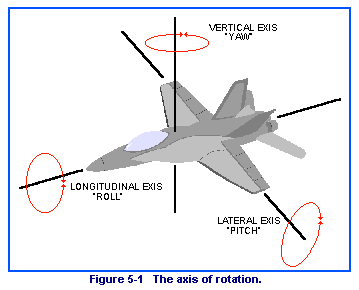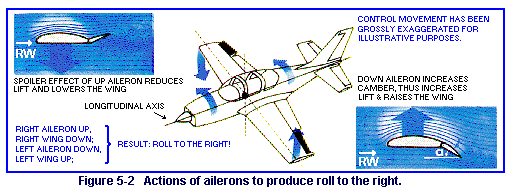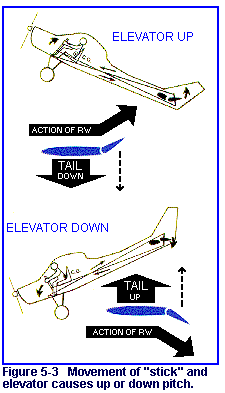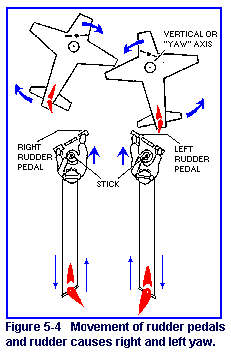 |
|||||
| Home | Research | For Teachers | HISTORY Level 1 Level 2 Level 3 |
PRINCIPLES Level 1 Level 2 Level 3 |
CAREER Level 1 Level 2 Level 3 |
| Gallery | Hot Links | What's New! | |||
| Web Administration and Tools | |||||
 |
|||||
| Home | Research | For Teachers | HISTORY Level 1 Level 2 Level 3 |
PRINCIPLES Level 1 Level 2 Level 3 |
CAREER Level 1 Level 2 Level 3 |
| Gallery | Hot Links | What's New! | |||
| Web Administration and Tools | |||||
![]()
Aircraft fly in three dimensions, and they move in directions other than straight and level. In order to examine these other directions, we have to take another look at our aircraft. In addition to moving forward, an aircraft in flight may move about three axes. See Figure 5-1 and you will understand what we mean. The simplest way to understand the axes is to think of them as long rods passing through the aircraft where each will intersect the other two. At this point of intersection, called the center of gravity, each of these axes is also perpendicular to the other two.

The axis that extends lengthwise (nose through tail) is called the longitudinal axis, and rotation about this axis is called roll. The axis that extends crosswise (wingtip through wingtip) is called the lateral axis, and rotation almost this axis is called pitch. The axis that passes vertically through the center of gravity (when the aircraft is in level night) is called the vertical axis, and rotation about this axis is called yaw. There is apparently no real rationale for these names; you simply have to memorize them (longitudinal axis-roll, lateral axis-pitch, and vertical axis-yaw).
If you hold a model in your hand in a straight and level manner and roll it so as to dip a wing, you are demonstrating roll around the longitudinal axis. If you hold it level and move the nose up and down, you are demonstrating movement around the lateral axis-that is, you are changing pitch. If you hold the model straight, and move it through the air while turning the nose to one side or the other, you have it yawing on its vertical axis; in other words, it is not moving forward in the direction in which the nose is pointing. An aircraft may move about one or all of these axes at the same time. With various types of turns and maneuvers, all three may be used.
As you begin to perceive, the axes of rotation control an aircraft's maneuverability. Still holding your model airplane, try the same movements again, but carry them further. Dip a wing and roll 180 degrees and you are flying upside down. Roll another 180 degrees and you are again straight and level. Your aircraft has executed a barrel roll.
Change pitch 90 degrees downward and you are diving toward the ground. Continue the rotation another 90 degrees and you have reversed your direction. You are also upside down. In other words, if you were flying east, upright, you are now flying west, upside down. Continue the rotation another 90 degrees and you are climbing straight up. Complete a 360-degree circle, and you are again flying east, straight and level. Your aircraft has executed an outside loop. To do an inside loop, change pitch in an upward direction, again making a complete circle.
Yaw, of course, is involved in every turn. You can describe turns of numerous degrees and angles with your model.
Now that we understand the axes of rotation, let's look at how the aircraft is controlled (moved) around these axes.

The Longitudinal Axis |
Press |
Running from the nose to the tail of an aircraft is the longitudinal axis (see figure 5-2). This axis can be thought of as a skewer which runs the length of the fuselage, and movement around the longitudinal axis is called roll.
The cause of movement or roll about the axis is the action of the ailerons. Ailerons are attached to the wing and to the control column in a manner that ensures one aileron will deflect downward when the other is deflected upward. How is it that deflecting an aileron causes the wing to move? Very simply, when an aileron is not in perfect alignment with the total wing, it changes the wing's lift characteristics. To make a wing move upward, the aileron on that wing must move downward. When this happens, the total lift being produced by that wing is increased. At the same time, the lift on the other wing is reduced. This causes the aircraft to roll.
The ailerons are attached to the cockpit control column by mechanical linkage. When the control wheel is turned to the right (or the stick is moved to the right), the aileron on the right wing is raised and the aileron on the left wing is lowered. This action increases the lift on the left wing and decreases the lift on the right wing, thus causing the aircraft to roll to the right. Moving the control wheel or stick to the left reverses this and causes the aircraft to roll to the left.
The Lateral Axis |
Press |
 The Lateral Axis is another name for the lateral
axis is the pitch axis. This name makes sense because the airplane is actually caused to
pitch its nose upward or downward around the lateral axis which runs from wingtip to
wingtip. What causes this pitching movement? It is the elevator which is attached to
the horizontal stabilizer. The elevator can be deflected up or down as the pilot moves the
control column (or stick) backward or forward. Movement backward on the control column
moves the elevator upward. As shown in Figure 5-3 , the relative wind striking the top
surface of the raised elevator pushes the tail downward. Since this motion is around the
lateral axis, as the tail moves (pitches) downward, the nose moves (pitches) upward and
the aircraft climbs. Deflection of the elevator downward creates the opposite effect and
the relative wind striking the lower surface of the elevator causes the tail to pitch up.
This, as you can see in Figure 5- , pitches the nose of the aircraft downward and the
airplane dives. Before leaving the horizontal stabilizer, we should introduce the term
stabilizer. Most aircraft designs no longer use a stabilizer with elevator arrangement.
Instead the entire horizontal tail surface is hinged so that the surface's angle of attack
is changed as the pilot pulls or pushes on the control column. This type of design is
doing the job of both a stabilizer and elevator so it is called a stabilator.
The Lateral Axis is another name for the lateral
axis is the pitch axis. This name makes sense because the airplane is actually caused to
pitch its nose upward or downward around the lateral axis which runs from wingtip to
wingtip. What causes this pitching movement? It is the elevator which is attached to
the horizontal stabilizer. The elevator can be deflected up or down as the pilot moves the
control column (or stick) backward or forward. Movement backward on the control column
moves the elevator upward. As shown in Figure 5-3 , the relative wind striking the top
surface of the raised elevator pushes the tail downward. Since this motion is around the
lateral axis, as the tail moves (pitches) downward, the nose moves (pitches) upward and
the aircraft climbs. Deflection of the elevator downward creates the opposite effect and
the relative wind striking the lower surface of the elevator causes the tail to pitch up.
This, as you can see in Figure 5- , pitches the nose of the aircraft downward and the
airplane dives. Before leaving the horizontal stabilizer, we should introduce the term
stabilizer. Most aircraft designs no longer use a stabilizer with elevator arrangement.
Instead the entire horizontal tail surface is hinged so that the surface's angle of attack
is changed as the pilot pulls or pushes on the control column. This type of design is
doing the job of both a stabilizer and elevator so it is called a stabilator.
The Vertical Axis |
Press |
 The third axis which passes
through the meeting point of the longitudinal and lateral axes from the top of the
aircraft to the bottom is called the vertical or yaw axis. The aircraft's nose moves
about this axis in a side-to-side direction. In other words, the airplane's nose is made
to point in a different direction when the airplane turns about this particular axis.
The third axis which passes
through the meeting point of the longitudinal and lateral axes from the top of the
aircraft to the bottom is called the vertical or yaw axis. The aircraft's nose moves
about this axis in a side-to-side direction. In other words, the airplane's nose is made
to point in a different direction when the airplane turns about this particular axis.
The airplane's rudder, which is moved by pressing on the rudder pedals, is responsible for movement about this axis (see figure 5-4 ). The rudder is a movable control surface attached to the vertical fin of the tail assembly. By pressing the proper rudder pedal, the pilot moves the rudder of the aircraft in the direction of the pedal he or she presses (right pedal moves the rudder to the right, and left pedal moves the rudder to the left). What happens then? When the pilot pushes the left rudder pedal, he or she then sets the rudder so that it deflects the relative air to the left. This then creates a force on the tail, causing it to move to the right and the nose of the aircraft to yaw to the left.
At this point, it is probably well to point out that the rudder does not steer the aircraft in normal flight. The rudder does not turn the aircraft; rather, its primary purpose is to offset the drag produced by the lowered aileron.
Send all comments to ![]() aeromaster@eng.fiu.edu
aeromaster@eng.fiu.edu
© 1995-98 ALLSTAR Network. All rights reserved worldwide.
| Funded in part by | From Civil Air Patrol Educational Materials |
Updated: February 23, 1999